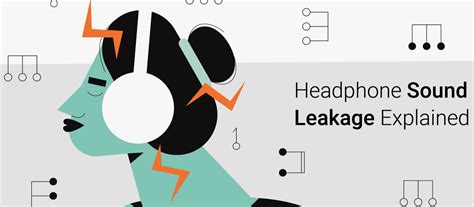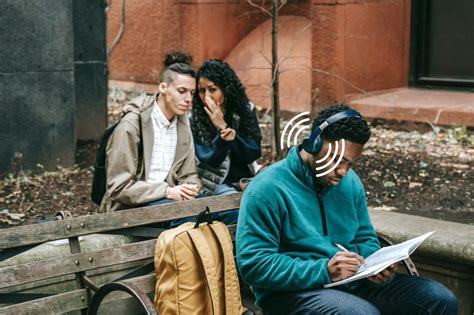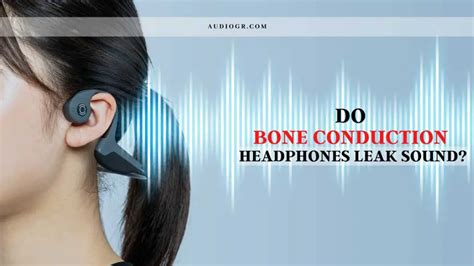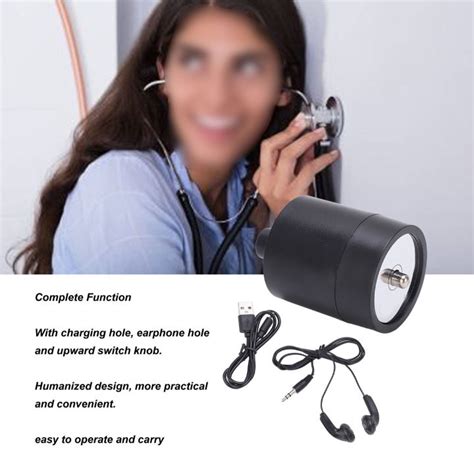Have you ever found yourself immersed in your favorite music, only to be startled by a friend tapping you on the shoulder, wondering how on earth they can hear what's playing in your headphones? The phenomenon of sound leaking from headphones is a perplexing one, leaving many baffled as to how sound can escape a confined space and reach the ears of those nearby.
This elusive phenomenon has intrigued audiophiles and scientists alike, provoking a quest to uncover the secrets lying beneath the surface of this auditory puzzle. To comprehend the complexities of sound propagation, we must delve into the intricate mechanisms of headphones and the science of sound transmission.
The delicate balance between electrical signals and acoustic waves lies at the heart of this enigma. As audio signals pass through the wires of your headphones, they undergo a transformation, converting electrical energy into vibrations that ultimately produce the sound you hear. But what happens when these vibrations escape the confines of their intended destination and permeate the surrounding environment?
Understanding Sound Leakage from Headphones

In this section, we will delve into the concept of sound leakage that occurs when using headphones.
Exploring the phenomenon where sound from headphones can be heard by others, it is important to understand the factors that contribute to this occurrence. When using headphones, the sound produced inside the ear cups is intended to be contained and directed solely towards the listener. However, due to various reasons, sound can leak out and become audible to those around.
One contributing factor to sound leakage is the design and construction of the headphones. The materials used and the overall fit of the headphone on the ears can affect how well the sound is contained. If the seal between the headphones and the listener's ears is not tight enough, sound can escape and be heard by others. Additionally, the type of headphones, such as open-back or closed-back, can also play a role in the degree of sound leakage experienced.
Another factor that can influence sound leakage is the volume at which the headphones are being used. Higher volume levels can increase the chances of sound escaping and being audible to those nearby. Similarly, the type of audio content being played can also impact the level of sound leakage. Certain genres or audio recordings may have a wider sound range, making it more likely for sound to leak out from the headphones.
To minimize sound leakage, it is important to consider these factors when choosing headphones and adjusting the volume levels. Ensuring a proper fit and choosing headphones designed for noise isolation can help keep the sound contained within the ear cups. Additionally, keeping the volume at a moderate level can prevent excessive sound leakage.
Understanding the reasons behind sound leakage from headphones can aid in making informed decisions when selecting headphones and using them in various environments.
The Science Behind Sound Leakage
Understanding the phenomenon of sound leakage from headphones requires a grasp of the fundamental principles of physics pertaining to sound transmission. This section explores the scientific principles that contribute to the sound escaping from headphones, reaching the ears of others nearby.
When sound is produced within a closed space, such as headphones, it is expected to remain confined and isolated. However, various factors influence the behavior of sound waves, facilitating their propagation through the air. These factors include the physical properties of the materials used in headphone construction, the positioning of the sound drivers, and the characteristics of the surrounding environment.
The materials employed in the design of headphones play a crucial role in determining the extent of sound leakage. Different materials exhibit varying degrees of sound absorption and reflection, affecting the overall acoustic performance. Additionally, the design and arrangement of the sound drivers within the headphones influence the directionality and dispersion of sound waves, which in turn affect the likelihood of sound escaping.
Moreover, the surrounding environment also plays a significant role in the amount of sound leakage. The presence of external sounds, such as ambient noise or loud music, can mask or enhance the perception of leaked sound. Additionally, the physical proximity between the headphones and other individuals can influence the level of audibility of the leaked sound.
Understanding the physics behind sound leakage can help improve headphone design and minimize the unintended transmission of sound to others. By employing materials with superior sound insulation properties, optimizing the arrangement of sound drivers, and considering environmental factors, manufacturers can create headphones that offer exceptional sound isolation and prevent sound leakage.
Factors Influencing Sound Leakage in Headphones

When using headphones, it is common to wonder why others can hear the audio playing from them. There are several factors that contribute to sound leakage in headphones, resulting in an audible sound being transmitted to people nearby. Understanding these factors can help in choosing the right headphones and ensuring a more private listening experience.
- Fit and Seal: One of the primary factors affecting sound leakage is the fit and seal of the headphones. If the headphones do not fit properly or create a proper seal around the ears, sound can leak out and be heard by others. Tight-fitting headphones or those with noise isolation features can help minimize sound leakage.
- Open or Closed Design: The design of the headphones also plays a significant role in sound leakage. Open-back headphones have vents or openings that allow sound to escape, resulting in more sound leakage. On the other hand, closed-back headphones have a solid construction that helps contain the sound within the ear cups, minimizing leakage.
- Volume Level: Another factor affecting sound leakage is the volume level at which the headphones are being used. Higher volume levels can increase the chances of sound leakage, particularly if the headphones do not provide good isolation or a tight fit.
- Quality of Headphones: The quality of the headphones themselves can impact sound leakage. Higher-end headphones often have better construction, materials, and technology that help minimize sound leakage. Cheaper or low-quality headphones may not provide the same level of sound isolation, resulting in more audible sound leaking out.
- Source of Audio: The type of audio being played can also influence sound leakage. Certain frequencies or sounds with a wide dynamic range may be more prone to leaking out of the headphones, even with good isolation.
By considering these factors, individuals can make informed choices when selecting headphones and take appropriate measures to reduce sound leakage. Whether it is through finding the right fit, opting for closed-back designs, or adjusting the volume levels, taking these factors into account can contribute to a more private listening experience.
The Influence of Headphone Design on Sound Leakage
In the realm of headphone technology, the construction and design of these devices play a pivotal role in controlling sound leakage. The manner in which sound travels from the headphones to the external environment can vary greatly based on the specific features and characteristics of the headphone design. This section delves into the impact that different headphone design elements can have on sound leakage, exploring how these variables can affect the privacy and audio experience of the listener.
Isolating the sound: One crucial factor in minimizing sound leakage is the ability of headphones to isolate sound within the ear cups. A well-designed headphone will have features that effectively seal off the ear from external sound, ensuring that the audio experience remains private. The materials used in the construction can significantly contribute to this isolation, with high-quality cushioning and foam padding providing an effective physical barrier against sound leakage.
Controlling sound wave reflection: The design of the internal sound chambers within the headphones also plays a significant role in influencing sound leakage. By strategically curving and shaping the pathways through which sound travels within the headphones, engineers can control the reflection of sound waves. This reduces the chances of sound exiting the headphones and being audible to others nearby. The use of materials with sound-absorbing properties further enhances this effect.
The importance of ear cup fit: A critical aspect of headphone design that impacts sound leakage is the fit and seal of the ear cups. Headphones that do not fit properly or have loose ear cups are more prone to sound leakage. In contrast, headphones that provide a secure and comfortable fit create a better seal, preventing sound from escaping. The design of the headband and adjustment mechanisms also play a role in ensuring a snug fit, enhancing privacy and reducing sound leakage.
Addressing sound leakage through open-back designs: On the other side of the spectrum, some headphones are intentionally designed with open-back structures that allow for a more natural and spacious audio experience. These designs intentionally allow some sound leakage to occur, enhancing soundstage and creating a more immersive listening experience. However, open-back headphones are not suitable for environments where privacy or blocking external noise is desired.
In conclusion, the design of headphones plays a crucial role in determining the level of sound leakage and the privacy of the listener. Effective sound isolation, control over sound wave reflection, proper fit, and the intentional use of open-back designs are all factors that influence sound leakage. Understanding these design elements can help individuals make informed decisions when selecting headphones that cater to their specific needs and preferences.
Tips for Reducing Sound Leakage in Your Headphones

Discover effective strategies to minimize sound leakage while using your headphones. By following these tips, you can ensure a more private listening experience without disturbing those around you.
1. Opt for Closed-Back Headphones:
Consider investing in closed-back headphones instead of open-back models. Closed-back headphones are designed to block external noise and prevent sound leakage, making them an ideal choice for those who prioritize privacy.
2. Adjust the Volume:
Listening at high volumes can increase the risk of sound leakage. Lower the volume to a moderate level, ensuring that you can still enjoy your music while minimizing the chances of others hearing it through your headphones.
3. Choose Over-Ear Headphones:
Over-ear headphones provide better noise isolation compared to on-ear or in-ear options. The cushioned ear cups create a seal around your ears, reducing sound leakage and preventing outside noise from interfering with your listening experience.
4. Select Noise-Canceling Headphones:
Noise-canceling headphones use advanced technology to reduce external noise. By eliminating ambient sounds, these headphones minimize the need for higher volume levels, decreasing the chances of sound leakage.
5. Use In-Ear Monitors:
If you prefer a more discreet option, consider using in-ear monitors (IEMs). These small, lightweight earphones fit snugly in your ear canal, creating a seal and effectively blocking out external noise. IEMs also provide excellent sound isolation, reducing sound leakage.
6. Check the Fit:
Ensure that your headphones fit properly and comfortably. A secure fit can help create a better seal, reducing sound leakage and improving sound quality.
7. Be Mindful of EQ Settings:
Adjust the equalizer (EQ) settings on your device to optimize the audio output. Enhancing certain frequencies can help prevent sound leakage by providing a more balanced sound while maintaining a lower volume level.
8. Consider In-Ear Tips:
If you are using earphones or earbuds, experiment with different sizes of in-ear tips. Finding the right size that fits your ears securely can improve noise isolation and minimize sound leakage.
9. Keep Background Noise in Check:
Minimize background noise in your surroundings to reduce the need for high volume levels. Lowering the volume decreases the chances of sound leakage and ensures a more enjoyable listening experience for yourself and those nearby.
10. Practice Good Headphone Etiquette:
Respect others' space and privacy by keeping the volume at a considerate level, particularly in public settings such as libraries, cafes, or shared workspaces. Being mindful of others' comfort will make the listening experience enjoyable for everyone.
By implementing these tips, you can minimize sound leakage from your headphones, allowing you to enjoy your favorite music or audio content without distracting or disturbing those around you.
Choosing Headphones with Minimal Sound Leakage
In this section, we will explore the process of selecting headphones that minimize the amount of sound leakage. When using headphones, it is important to consider the level of sound that can be heard by others around you. This section will provide tips and guidelines on how to choose headphones that offer a low level of sound leakage, allowing for a more enjoyable and private listening experience.
- Consider closed-back headphones: Closed-back headphones are designed to isolate sound and prevent sound leakage. The closed-back design features solid ear cups that effectively seal the sound, reducing the amount of audio that can be heard by others nearby. This makes them an ideal choice for situations where privacy is important.
- Look for noise-cancellation feature: Headphones with active noise-cancellation technology not only provide a more immersive listening experience but also minimize sound leakage. By actively monitoring external noises and producing opposing sound waves, these headphones can effectively reduce the sound that reaches those around you.
- Check for proper fit: A secure and proper fit plays a crucial role in reducing sound leakage. Make sure the headphones fit comfortably over your ears and create a good seal. Headphones with adjustable headbands and ear cup rotation can ensure a personalized fit, minimizing the escape of sound.
- Opt for over-ear or in-ear headphones: Over-ear and in-ear headphones are known for their ability to minimize sound leakage. Over-ear headphones encompass the entire ear, preventing sound from escaping. In-ear headphones fit snugly inside the ear canal, providing a higher level of isolation against external sounds, reducing the chance of sound leakage.
- Consider low-impedance headphones: Headphones with lower impedance require less power to drive them, resulting in reduced sound leakage. Lower impedance headphones are generally more suitable for portable devices such as smartphones, tablets, or laptops.
When choosing headphones with low sound leakage, it is essential to prioritize your specific needs, considering factors such as noise isolation, comfort, and personal preferences. By following these guidelines and understanding the different features available, you can select headphones that provide an immersive listening experience while minimizing the inconvenience of sound leakage for those around you.
Social Etiquette and Leakage of Audio from Personal Listening Devices

In today's interconnected society, the use of personal listening devices, such as headphones, has become ubiquitous. While these devices offer individuals a private and immersive audio experience, they can inadvertently affect those around them due to sound leakage. A discussion on social etiquette regarding headphone sound leakage is essential to navigate this modern challenge.
1. Respecting Personal Space: When using headphones in public spaces, it is important to recognize that others nearby may be able to hear the audio leaking from the headphones. Respecting the personal space of others means being mindful of the volume levels to avoid causing discomfort or disturbance. Adjusting the volume to a level where it is only audible to the listener helps maintain a considerate environment.
2. Awareness of Surroundings: While engrossed in personal audio, it is easy to forget that others may be present. Remaining aware of one's surroundings can help prevent unintentional sound leakage. Engaging in self-awareness and periodically checking the volume levels and the amount of audio leakage ensures that others are not unnecessarily exposed to the sound.
3. Public Spaces vs. Private Settings: Understanding the distinction between public spaces and private settings is crucial. In public spaces, such as libraries, public transportation, or cafes, headphones should be used with discretion to minimize sound leakage. Conversely, in the privacy of one's home or designated personal spaces, the concern for sound leakage may not be as significant, as long as it does not disturb others.
4. Usage of Noise-Canceling Headphones: Noise-canceling headphones are designed to minimize external sounds while providing a high-quality audio experience. Using these headphones can significantly reduce sound leakage and contribute to enhancing the social etiquette of personal audio usage. Opting for noise-canceling options can demonstrate consideration for those nearby.
5. Communication with Others: In situations where sound leakage may be unavoidable, such as shared workspaces or crowded transportation, communication with those nearby can help mitigate any potential discomfort. Seeking permission or informing others about the audio leaking from headphones can foster understanding and cooperation among individuals sharing the same space.
To ensure a harmonious coexistence in our modern, technology-driven world, adhering to appropriate social etiquette regarding headphone sound leakage is imperative. By following these suggested practices, individuals can enjoy their personal audio experience while being mindful of those around them.
[MOVIES] [/MOVIES] [/MOVIES_ENABLED]FAQ
Why do people hear the sound coming from my headphones?
When you're using headphones, the sound is intended to be heard only by you. However, sometimes there can be several reasons why others might still be able to hear the sound from your headphones. Firstly, it could be due to sound leakage. If your headphones are not properly sealed, sound can escape and be audible to those around you. Secondly, the volume level might be too high. If you have your headphones set to a very high volume, it becomes easier for others nearby to hear the sound. Lastly, the type of headphones you're using can also play a role. Some types of headphones, like open-back or on-ear headphones, are designed to allow some sound to pass through, making it more likely for others to hear it.
Is it possible for others to hear the sound from my headphones if I'm using noise-canceling headphones?
Noise-canceling headphones are designed to reduce external sounds around you, but they might not completely eliminate sound leakage. While they can significantly reduce the amount of sound that escapes, it is still possible for others to hear what you're listening to if the volume is very high or if there are other factors, such as the type of headphones you're using or the fit of the headphones.
How can I prevent others from hearing the sound from my headphones?
To minimize others hearing the sound from your headphones, there are a few steps you can take. Firstly, consider using headphones with closed-back or in-ear designs, as they provide better sound isolation and reduce sound leakage. Additionally, be mindful of the volume level and avoid listening at excessively high volumes. Finally, if you often listen to music or watch movies in public places where others are nearby, it might be considerate to use headphones specifically designed for noise isolation or use noise-canceling headphones.
Can using headphones with a higher impedance help prevent others from hearing the sound?
Headphones with higher impedance can reduce the risk of sound leakage, as they require more power to drive them properly. However, it is not solely the impedance that determines whether others can hear the sound from your headphones. The design and fit of the headphones, the volume level, and other factors also play a significant role. So, while higher impedance can help, it is not a foolproof solution.
Is there anything I can do if I still want to use open-back headphones but don't want others to hear the sound?
If you prefer using open-back headphones but want to prevent others from hearing the sound, there are a couple of options you can explore. Firstly, you can try using a headphone amplifier with a volume control to adjust the output level. This allows you to keep the volume at a comfortable level without it being too loud for those nearby. Alternatively, you can try using a headphone stand with a hanger attachment that holds the headphones away from your ears when you're not using them. This can help reduce the sound leakage to some extent.




